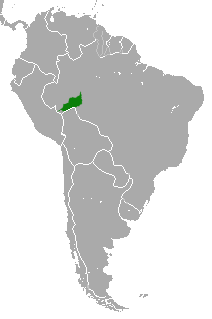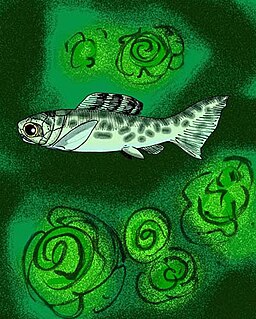Related Research Articles

Rhabditida is an order of free-living, zooparasitic, and phytoparasitic microbivorous nematodes living in soil.

The little ringed plover is a small plover. The genus name Charadrius is a Late Latin word for a yellowish bird mentioned in the fourth-century Vulgate. It derives from Ancient Greek kharadrios a bird found in river valleys. The specific dubius is Latin for doubtful, since Sonnerat, writing in 1776, thought this bird might be just a variant of common ringed plover.

The bearded barbet is an African barbet. Barbets and toucans are a group of near passerine birds with a worldwide tropical distribution. The barbets get their name from the bristles which fringe their heavy bills.

Ixobrychus is a genus of bitterns, a group of wading bird in the heron family Ardeidae. Ixobrychus is from Ancient Greek ixias, a reed-like plant and brukhomai, to bellow.

Hershkovitz's titi is a species of titi, a type of New World monkey, from South America. It is found in Bolivia, Brazil, and Peru. The common name is in reference to American zoologist Philip Hershkovitz, who described the species as Callicebus dubius in 1988.
Tylenchorhynchus brevilineatus is a plant pathogenic nematode infecting peanut.
Tylenchorhynchus claytoni is a plant pathogenic nematode.
Tylenchorhynchus maximus is a plant pathogenic nematode infecting barley.
Tylenchorhynchus nudus is a plant pathogenic nematode cause dwarfing disease specially at rice plant.
Tylenchorhynchus phaseoli is a plant pathogenic nematode infecting pearl millet.
Tylenchorhynchus vulgaris is a plant pathogenic nematode infecting pearl millet.
Tylenchorhynchus is a genus of nematodes including many species of plant parasites. The classification of stunt nematodes - those including the genus Tylenchorhynchus - is unstable; many newly discovered species within this genus are reconsidered to be actually subspecies. Stunt nematodes such as Tylenchorhynchus and the closely related genera, Anguillulina and Merlinia, include more than 250 known species. Members of these genera possess similar anatomy and may be easily mistaken for one another. Some debate has led to the classification of single species under different names in two distinct genera.
T. vulgaris may refer to:

Isopogon dubius, the pincushion coneflower, is a small shrub that is endemic to the south-west of Western Australia. It is usually between 0.3 and 1.5 metres high and has divided leaves which are 40 to 50 mm in length
A. dubia may refer to:

Microsteus is a genus of small selenosteid arthrodire placoderms known from the Upper Frasnian Kellwasserkalk facies of Late Devonian Germany.

Anochetus dubius is an extinct species of ant in the subfamily Ponerinae known from two possibly Miocene fossils found on Hispaniola. A. dubius is one of eight species in the ant genus Anochetus to have been described from fossils found in Dominican amber and is one of a number of Anochetus species found in the Greater Antillies.

Pandanus dubius, commonly known as bakong or knob-fruited screwpine, is a species of Pandanus (screwpine) native to the Andaman and Nicobar Islands, Island Southeast Asia, New Guinea, and the Western Pacific islands.
Peramus is the only confirmed genus in the family Peramuridae, and a possible ancestor of early therians. It lived in the Late Jurassic and Early Cretaceous period.
References
- ↑ "Tylenchorhynchus dubius | NBN Atlas". species.nbnatlas.org. Retrieved 2020-04-05.